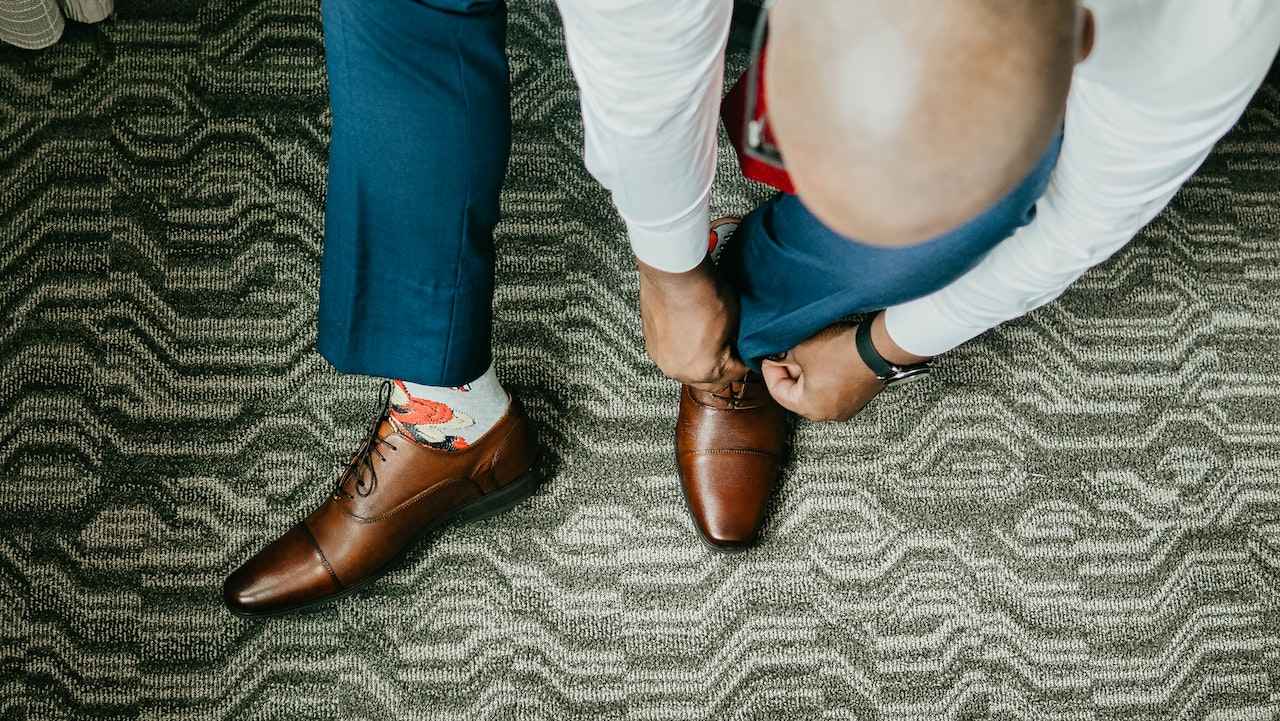Have you had hip replacement surgery and wonder when you can get back to simple things like tying your shoes? The good news is that you’ll likely be able to do it after about 6-8 weeks. I’ve been through this myself, and I know how frustrating those first few weeks can be. By following your doctor’s instructions and taking it slow, you’ll be able to manage everyday tasks like this again. Let’s talk about how to make it happen!
Factors Affecting
After undergoing a hip replacement surgery, the time it takes to be able to tie your shoes can vary among individuals. Several factors influence the ease with which you can perform this task. Understanding the healing process is crucial in this regard.
Each person’s recovery and rehabilitation progress at different rates, depending on their overall health, age, and adherence to post-operative instructions. While some individuals may regain the ability to tie their shoes within a few weeks, others may take longer. Physical therapy and exercises play a significant role in recovering the strength, flexibility, and balance necessary for tying shoes independently.
It is important to consult with your healthcare provider and follow their guidance regarding when it is safe to resume this activity.
The Recovery Process
The recovery time after a hip replacement surgery can vary based on the surgical technique used. There are different techniques that surgeons can employ during a hip replacement procedure. The choice of technique can have an impact on the time it takes for patients to be able to tie their shoes comfortably.
Some techniques, such as minimally invasive surgery, may result in a quicker recovery compared to traditional open surgery. This is because minimally invasive techniques involve smaller incisions and less disruption to surrounding tissues. Additionally, some techniques may also reduce the risk of complications and allow for a faster return to normal activities.
Ultimately, it is important to discuss the surgical techniques with your surgeon to understand how they may affect your recovery time.
General Recovery Timeline After Hip Replacement Surgery
The recovery timeline varies but typically involves hospital care for 1-2 days. Your vital signs will be monitored, and pain managed. You’ll start gentle exercises and mobility while in the hospital.
Once at home, the next few weeks can bring discomfort, managed with prescribed pain relief. Follow surgeon’s instructions for wound care, medication, and restrictions. You may use crutches or a walker at first.
Over 6-8 weeks, you’ll regain mobility and return to light activities. Full recovery takes 3-6 months. Patience and following your rehab plan are essential.
The Initial Post-Op Phase and Immediate Recovery Tips
The hospital stay is short but critical. Monitor post-op discomfort and adhere to exercise routines to prevent stiffness and blood clots.
After returning home, adjust your surroundings for safety. Follow wound care and medication instructions. Maintain a balanced diet, hydration, and rest. Be vigilant about unusual symptoms and contact your healthcare provider if needed.
The Importance of Rehabilitation and Physical Therapy
Rehabilitation and physical therapy are vital. Tailored exercises improve hip function, strength, and balance.
Rehabilitation includes home exercises. Be diligent in following your plan. This enhances daily function and overall recovery.
Consistent communication with your healthcare team and effort in rehabilitation are crucial for success.
Rehabilitation And Physiotherapy For Optimal Recovery
Rehabilitation exercises play a crucial role in restoring strength and flexibility after a hip replacement. These exercises are essential to speed up the recovery process and provide long-term benefits. Physiotherapy is an important component of rehabilitation as it helps regain balance and coordination.
A physiotherapist will create a personalized exercise plan based on your individual needs and progress. They will guide you through various exercises and techniques to improve range of motion, build muscle strength, and enhance overall mobility. The goal is to gradually increase your ability to perform daily activities, such as tying your shoes, without any discomfort or difficulty.
Following a structured rehabilitation program and working closely with a physiotherapist will ensure optimal recovery and help you return to your normal activities as soon as possible.
Expected Time Frame For Effortless Shoe Tying Post Surgery
Recovery time after hip replacement surgery can vary for individuals. It is best to consult with your surgeon to determine the expected time frame for effortless shoe tying post-surgery. While there is a general timeline for recovery after a hip replacement, it is important to consider various factors that can influence your individual recovery.
These factors include your age, overall health, any complications during surgery, and adherence to post-operative instructions and rehabilitation exercises. Your surgeon will be able to provide you with specific guidelines on when it is safe to tie your shoes comfortably.
It is crucial to listen to your body and gradually resume your normal activities, including shoelace tying, to avoid any setbacks in your recovery. Remember to follow your surgeon’s advice and take the necessary precautions to ensure a successful and smooth recovery process.
Recovery Milestones For Independent
Recovery after hip replacement surgery varies, but achieving the milestone of independent shoe tying generally takes some time. It is essential to follow the rehabilitation guidelines provided by your healthcare professional. These guidelines will help you progress towards regaining your mobility and strength.
By diligently following the instructions, you can optimize your recovery process and reduce the risk of complications. Along with physical therapy exercises, taking care of your incision site and allowing it to heal properly is crucial. It is recommended to consult your healthcare team to understand the typical time frame for achieving independent shoe tying, as it may vary depending on individual circumstances.
Patience and consistency in following the recommended protocols will ultimately help you regain your ability to tie your shoes independently once again.
Tying Shoes After Hip Replacement
Tips for Safe Shoe Tying
After hip replacement surgery, tying shoes can be tough due to limited hip mobility. To ease this, use a long-handled shoe horn or sock aid for minimal bending. Slip-on or Velcro shoes are easier options. Elastic laces turn shoes into slip-ons, reducing the need for tying. Sit down to put on your shoes to avoid bending.
Adaptive Tools and Methods
Consider adaptive tools like a shoe fastener kit with long handles for easier lace threading. Magnetic shoelaces eliminate knots; just bring magnets together to secure and pull apart to remove. Elastic laces with locking mechanisms provide a snug fit without frequent adjustments. Consult an occupational therapist for personalized recommendations. These solutions simplify the shoe-tying process, promoting independence in daily life.
Tips And Tricks For Easier Shoe Tying During Recovery
Recovering from a hip replacement surgery requires patience and careful consideration of everyday tasks. One common concern is tying shoes, but it’s important to follow the proper timeline for healing. While it’s best to consult with your doctor for personalized advice, typically you can start tying your shoes again in about six to eight weeks after surgery.
During this recovery period, there are several tips and tricks to make the process easier. Firstly, consider using adaptive equipment or aids designed specifically for shoe tying. These can range from long-handled shoe horns to elastic shoelaces that don’t require tying.
Additionally, try techniques that minimize strain and maximize comfort, such as sitting on a raised surface or using a grabber tool for easier access. By following these suggestions, you can regain your independence in shoe tying while allowing yourself ample time to heal and recover properly.
Physical Limitations And Modifications For Shoe Tying
After undergoing hip replacement surgery, it is common to experience physical limitations that can affect your ability to tie your shoes. These limitations may include reduced flexibility and range of motion in the hip area, as well as difficulty bending down or reaching your feet.
However, there are modifications you can consider to make shoe tying easier during the recovery period. One option is to use adaptive equipment, such as long-handled shoehorns or elastic laces, which can minimize the need for bending and reaching. Another approach is to modify your shoe selection, opting for slip-on shoes or those with velcro closures to eliminate the need for tying altogether.
Additionally, performing exercises recommended by your physical therapist can help improve your hip flexibility and make shoe tying more manageable as you continue to recover. By taking these factors into consideration, you can ensure a smoother transition towards independent shoe tying after hip replacement surgery.
Strategies For Bending And Balance Support
After undergoing a hip replacement surgery, it is important to be cautious when bending and reaching. To minimize the strain while tying shoes, there are techniques that can be implemented. One strategy is to utilize assistive devices like shoe horns or long-handled reachers, which help to reduce the need for excessive bending.
Another technique is to sit on a chair or use a stable surface to support your balance while performing the task. Additionally, bringing your foot up towards your chest instead of leaning over can also minimize the strain on your hip.
Remember to take it slowly and listen to your body, as everyone’s recovery timeline may differ. With these strategies, you can gradually regain your independence and confidently tie your shoes after a hip replacement surgery.
Adaptive Shoelace Methods And Shoe Options
After undergoing hip replacement surgery, you may wonder how long it will take to tie your shoes comfortably. Luckily, there are adaptive shoelace methods and shoe options available to make this task easier. By using alternative shoelace methods, such as elastic shoelaces or lock laces, you can manipulate your shoes with minimal effort.
Additionally, choosing shoes that are easier to manage post-surgery can greatly assist in the process. Opt for slip-on shoes or those with velcro closures, as they eliminate the need for tying laces altogether. Ultimately, the time it takes to tie your shoes after hip replacement surgery will vary depending on your individual progress and recovery.
However, by utilizing adaptive shoelace methods and selecting suitable shoe options, you can regain your independence and confidently tie your shoes once again.

Gradual Recovery And Learning New Techniques
Understanding the gradual recovery process post-hip replacement surgery is essential. Patience plays a crucial role in this recovery journey. Learning new techniques to tie your shoes may take time, but it is important to stay committed. By practicing these new techniques regularly, you can regain your ability to tie your shoes comfortably.
It is important to remember that each person’s recovery timeline may vary. However, being diligent in your efforts will contribute to a smoother recovery and improved independence. So, don’t get discouraged if it takes longer than expected. Stay focused, keep practicing, and soon you will be able to tie your shoes without any difficulty.
Progressive Shoes Tying Exercises And Training
After undergoing hip replacement surgery, the question of when one can resume tying their shoes is common. To facilitate this process, progressive exercises aimed at strengthening the muscles involved in shoe tying can be beneficial. Trainer-led sessions can provide guidance on proper techniques to prevent discomfort during the process.
These exercises can gradually enhance muscle strength, enabling individuals to regain their ability to tie their shoes independently. Rather than relying on commonly overused phrases, it is important to focus on clear and concise communication. This article intends to provide valuable information on progressive shoe-tying exercises and training that can expedite the recovery process after a hip replacement surgery.
Seeking Professional Advice For Proper Rehabilitation
Seeking professional advice for proper rehabilitation after hip replacement surgery is crucial. Healthcare professionals can provide personalized guidance to assist in your recovery journey. Their expertise can help accelerate the healing process and improve your technique while tying your shoes.
Consulting with a healthcare professional ensures that you receive specialized care tailored to your specific needs. Their knowledge and experience can address any concerns you may have and provide valuable insights into returning to your daily activities safely. By following their recommendations and guidance, you can regain your mobility and independence more efficiently.
Don’t hesitate to reach out to healthcare professionals for the support you need during your hip replacement recovery.
Personal Accounts And Tips From Hip Replacement Patients
How long it takes to be able to tie your shoes after hip replacement surgery varies among individuals. Patients who have undergone the procedure may offer personal accounts and helpful tips. By sharing their real-life experiences and insights, they provide valuable advice on recovering from hip replacement.
These individuals have gathered tips and tricks to aid others in the healing process. From adjusting techniques to utilizing tools or assistance, they offer practical strategies for regaining independence. While there is no definitive timeline for when you can tie your shoes again, the stories and advice of fellow patients can be a valuable resource through your recovery journey.
Remember to consult with your doctor for personalized guidance and recommendations tailored to your specific condition and progress.
Success Stories And Realistic Expectations
Following a successful hip replacement surgery, many patients wonder when they can comfortably tie their shoes. It’s important to set realistic expectations for recovery, and hearing inspiring stories from others who have gone through the same experience can be encouraging.
These stories highlight the triumphs of individuals who have successfully regained their ability to tie their own shoes after hip replacement. By sharing their experiences, we can understand that the time frame for this achievement varies among individuals. It’s important to remember that everyone’s recovery journey is unique, and it’s essential to listen to your body and follow your healthcare provider’s guidance.
While it’s impossible to provide an exact timeframe, hearing others’ success stories can inspire and motivate you as you navigate your own recovery.
Practical Tips For Smooth Shoe Tying Journey
After undergoing a hip replacement surgery, patients often wonder how long it will take before they can tie their shoes again. To help you navigate this journey, we have gathered practical advice and recommendations from those who have gone through the recovery process.
While everyone’s experience may differ, it is important to listen to your body and follow your surgeon’s instructions. Some patients have found it helpful to use adaptive tools such as long-handled reachers or elastic shoelaces to simplify the process. Others recommend sitting on a stable surface while putting on their shoes to maintain balance and stability.
Patience and perseverance are key during this phase of your recovery. Remember to take it slowly and gradually increase your range of motion. It’s important to prioritize your healing and adapt to any challenges that may arise, as your body continues to recover and regain strength.

Frequently Asked Questions
How Long Does It Take To Tie My Shoes After Hip Replacement Surgery?
Most people can tie their shoes on their own within 2 to 6 weeks after hip replacement surgery.
Is It Difficult To Tie My Shoes After Hip Replacement Surgery?
Tying your shoes may be a bit challenging initially but with practice, it becomes easier over time.
What Precautions Should I Take When Tying My Shoes After Hip Replacement?
Avoid bending at the waist; instead, bend your knees and raise your foot up towards your body to tie your shoes.
Can I Use Any Special Technique To Tie My Shoes After Hip Replacement?
Consider using a long-handled shoe horn or elastic shoelaces to make it easier to put on and tie your shoes.
Are There Any Tools Or Aids Available For Tying Shoes After Hip Replacement?
Yes, you can use tools like a reacher or adaptive devices that help you put on and tie your shoes with greater ease.
Can I Ask For Help With Tying My Shoes After Hip Replacement?
Certainly, if you find it difficult or uncomfortable, don’t hesitate to ask for assistance from a caregiver or loved one.
How Long Before I Can Tie My Shoes Without Any Help After Hip Replacement?
With proper rehabilitation and healing, you should be able to tie your shoes independently within a few weeks after surgery.
Conclusion
Recovering from a hip replacement surgery is a gradual process that requires patience and adherence to your medical team’s advice. While the recovery timeline can vary for each individual, it is generally safe to start tying your shoes about four to six weeks after the surgery.
Remember to be gentle and avoid any sudden movements or excessive bending. It is advised to sit down and use adaptive equipment, such as a long-handled shoe horn or elastic shoe laces, to make the task easier and more comfortable.
As time passes, you will regain strength and flexibility in your hip, allowing you to perform daily tasks, including tying your shoes, with more ease. By following a proper recovery plan and maintaining an active lifestyle, you will be able to resume your normal activities and regain your independence after hip replacement surgery.


